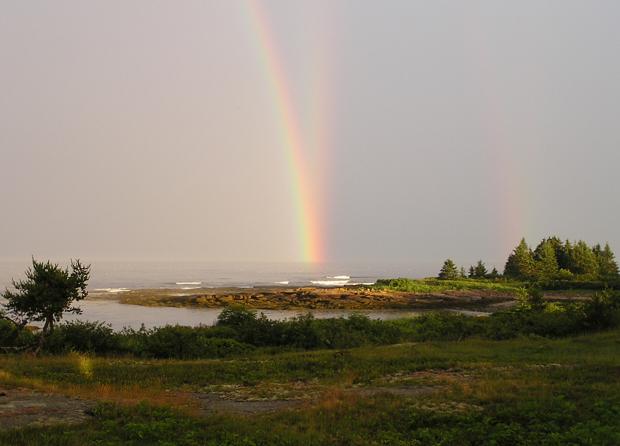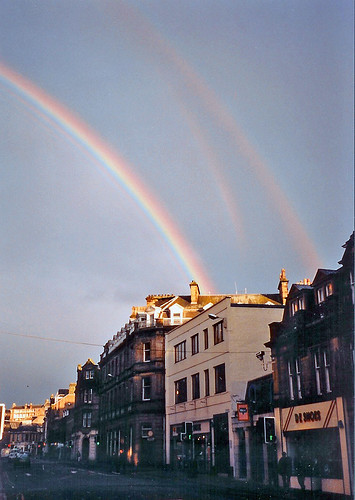It looks like you're using an Ad Blocker.
Please white-list or disable AboveTopSecret.com in your ad-blocking tool.
Thank you.
Some features of ATS will be disabled while you continue to use an ad-blocker.
1
share:
Triple Rainbows Exist, Photo Evidence Shows
www.sciencedaily.com...
I believe a song in celebration due:
Enjoy!
www.sciencedaily.com...
Few people have ever claimed to see three rainbows arcing through the sky at once. In fact, scientific reports of these phenomena, called tertiary rainbows, were so rare -- only five in 250 years -- that until now many scientists believed sightings were as fanciful as Leprechaun's gold at a rainbow's end. These legendary optical rarities, caused by three reflections of each light ray within a raindrop, have finally been confirmed, thanks to photographic perseverance and a new meteorological model that provides the scientific underpinnings to find them.
The work is described in a series of papers in a special issue published this week in the Optical Society's (OSA) journalApplied Optics.
In addition to the confirmed photo of a tertiary rainbow, the optical treasure hunt went one step further, as revealed in another photo that shows the shimmering trace of a fourth (quaternary) rainbow.
Raymond Lee, a professor of meteorology at the U.S. Naval Academy, did not snap those pictures, but he did make them possible. One year ago, Lee predicted how tertiary rainbows might appear and challenged rainbow chasers to find them
I believe a song in celebration due:
Enjoy!
edit on 6-10-2011 by MasterGemini because: (no reason given)
reply to post by MasterGemini
I read this one on science daily earlier and I was a little disappointed with the scientific interpretation of a triple rainbow. You have turn around and look back into the glare of the sun to find it?
maybe its just me or I read it all wrong, "well technically if you look over here" sort of defeats the notion of a 3rd rainbow at the same time proves it
I read this one on science daily earlier and I was a little disappointed with the scientific interpretation of a triple rainbow. You have turn around and look back into the glare of the sun to find it?
maybe its just me or I read it all wrong, "well technically if you look over here" sort of defeats the notion of a 3rd rainbow at the same time proves it
I saw a picture of a quad rainbow today somewhere on the web, but I can't remember where. What's causing this?
Originally posted by MasterGemini
Triple Rainbows Exist, Photo Evidence Shows
Although for anyone who understood the article, the real big news is that QUATERNARY rainbows also exist and so you can have FOUR in the sky at the same time.
I read this yesterday on ATS, a website with a search function.
Originally posted by alfa1
Originally posted by MasterGemini
Triple Rainbows Exist, Photo Evidence Shows
Although for anyone who understood the article, the real big news is that QUATERNARY rainbows also exist and so you can have FOUR in the sky at the same time.
I read this yesterday on ATS, a website with a search function.
Just did ANOTHER search with "triple rainbow" in it and nothing came up.
Now if you wanted me to search for QUATERNARY rainbow, which is not in the sciencedaily headline, I can find what you are talking about. . .
Oh and the article was posted on Oct 6 2011 to Sciencedaily FYI
edit on 7-10-2011 by alien because: (no reason given)
I think 5 in 250 years is a bit of a stretch of the imagination. I found 6 images and 2 vids.
This one isnt very clear but it is a tripple

This one isnt very clear but it is a tripple

edit on 7-10-2011 by PhoenixOD because: (no reason given)
Love the pictures.
The best rainbow I ever saw was over a strip mall in Birmingham.
I kid you not. One end of that sucker went to the ground at the rear of a bank.
I have wished a million times I had had a camera.
The best rainbow I ever saw was over a strip mall in Birmingham.
I kid you not. One end of that sucker went to the ground at the rear of a bank.
I have wished a million times I had had a camera.
edit on 7-10-2011 by hdutton because: (no reason given)
Originally posted by PhoenixOD
I think 5 in 250 years is a bit of a stretch of the imagination. I found 6 images and 2 vids.
This one isnt very clear but it is a tripple
The thread title is misleading.
The news is not about a "triple rainbow", its actually about new photographic evidence that rainbows can be caused by light bouncing around through raindrops is such a specific way as to cause what they call a "tertiary" rainbow, where there is three reflections of each light ray within a raindrop, and the light is sent back out at a quite specific angle.
Optical experts have apparently been arguing over the possibility of this specific effect being possible for many years now.
The photos you posted, while very pretty, have nothing to do with this optical phenomenon.
reply to post by iforget
Nice photoshopping
(though I appreciate PhoenixOD is not responsible) The clue is the secondary bow being too close and at a different angle to the primary and alleged tertiary bows.
and btw, this is not a 'quarternary' bow either. It's a typical double bow with supernumeraries
Nice photoshopping
(though I appreciate PhoenixOD is not responsible) The clue is the secondary bow being too close and at a different angle to the primary and alleged tertiary bows.
and btw, this is not a 'quarternary' bow either. It's a typical double bow with supernumeraries
edit on 7-10-2011 by Essan because: (no reason given)
reply to post by Essan
yeah could be Ive never seen a rainbow like that I did notice the differing angels
yeah could be Ive never seen a rainbow like that I did notice the differing angels
reply to post by Essan
They are not my pictures but im not so sure that the odd angle is evidence of Photoshopping.
- Would someone attempting to Phototshop go for such a strange angle?
- Why is it the same strange angle in every picture? All the pictures are from different sources taken at different times.
- What about the videos? even they show strange angled rainbows?
They are not my pictures but im not so sure that the odd angle is evidence of Photoshopping.
- Would someone attempting to Phototshop go for such a strange angle?
- Why is it the same strange angle in every picture? All the pictures are from different sources taken at different times.
- What about the videos? even they show strange angled rainbows?
reply to post by PhoenixOD
I can't see that it's physically possible and the phenomena has never to my knowledge been raised in meteorological circles.
But I'll make some enquiries
Edit: looking at that video again, there appears to be 2 double rainbows
I can't see that it's physically possible and the phenomena has never to my knowledge been raised in meteorological circles.
But I'll make some enquiries
Edit: looking at that video again, there appears to be 2 double rainbows
edit on 7-10-2011 by Essan because: (no reason given)
Scientists have captured the first image of a "quaternary" rainbow - the fourth rainbow caused by the bending of light through water in the air. This refraction frequently creates a visible second rainbow, but until now, no-one had caught sight of the fainter third and fourth arcs that the process creates in a different part of the sky. The first tertiary, or third, rainbow has only just been caught on film.
Here ya go, this goes one better!
Linky Dinky Doo
Well, you learn something new every day, even old dogs like me
What the video and photos show is a reflection rainbow
Something to look out for!
(thanks to my friends on Ukweatherworld for that )
What the video and photos show is a reflection rainbow
Something to look out for!
(thanks to my friends on Ukweatherworld for that )
new topics
-
Turns out, they planned to go after P-nut.
US Political Madness: 37 minutes ago -
Sick sick sick
Social Issues and Civil Unrest: 6 hours ago -
Comcast dumping MSNBC
Mainstream News: 9 hours ago
top topics
-
Comcast dumping MSNBC
Mainstream News: 9 hours ago, 15 flags -
President-elect TRUMP Picks MATT GAETZ for his ATTORNEY GENERAL - High Level PANIC Ensues.
2024 Elections: 12 hours ago, 13 flags -
Mike Tyson returns 11-15-24
World Sports: 17 hours ago, 5 flags -
Turns out, they planned to go after P-nut.
US Political Madness: 37 minutes ago, 5 flags -
Sick sick sick
Social Issues and Civil Unrest: 6 hours ago, 4 flags
active topics
-
Sick sick sick
Social Issues and Civil Unrest • 23 • : Irishhaf -
President-Elect Donald Trump will Meet with Coup-Victim JOE BIDEN on Wed 11.13.2024.
2024 Elections • 34 • : Irishhaf -
The Acronym Game .. Pt.4
General Chit Chat • 944 • : tinkerbell99 -
Turns out, they planned to go after P-nut.
US Political Madness • 3 • : nugget1 -
WATCH LIVE: US Congress hearing on UFOs, unidentified anomalous phenomena
Aliens and UFOs • 37 • : putnam6 -
Alex Jones Reinstated on X
Education and Media • 80 • : starvosan -
How can you defend yourself when the police will not tell you what you did?
Posse Comitatus • 74 • : network dude -
President-elect TRUMP Picks MATT GAETZ for his ATTORNEY GENERAL - High Level PANIC Ensues.
2024 Elections • 43 • : network dude -
HHS Spent Hundreds of Millions of Dollars on DEI Initiatives Under Biden, Watchdog Finds
US Political Madness • 6 • : marg6043 -
My aunt kidnapped my father.
Rant • 17 • : BrotherKinsMan
1




